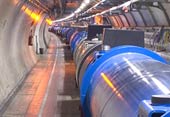|
Scientist at Geneva-based European Organisation for Nuclear Research (CERN) have managed to restart the Large Hadron Collider (LHC) designed to recreate the Big Bang of the universe, after more than a year of repairs, the organisation said yesterday.  This news comes after the machine was handed over for operation on Wednesday morning, where a clockwise circulating beam was established the following day. This will make an important milestone on the road towards first physics at the LHC, expected in 2010. This news comes after the machine was handed over for operation on Wednesday morning, where a clockwise circulating beam was established the following day. This will make an important milestone on the road towards first physics at the LHC, expected in 2010.
"It's great to see beam circulating in the LHC again," said CERN director-general Rolf Heuer. "We've still got some way to go before physics can begin, but with this milestone we're well on the way." The LHC is the world's largest and highest-energy particle accelerator, intended to collide opposing particle beams of either protons at very high energy. It is expected that it will address the most fundamental questions of physics, which seem to block further progress in understanding the deepest laws of nature. The LHC, which was built by the European Organization for Nuclear Research, lies in a tunnel 27 km in circumference, as much as 175 metres beneath the Franco-Swiss border near Geneva, Switzerland. It is funded by and built in collaboration with over 10,000 scientists and engineers from over 100 countries as well as hundreds of universities and laboratories. At present, CERN's member states include Austria, Belgium, Bulgaria, the Czech Republic, Denmark, Finland, France, Germany, Greece, Hungary, Italy, the Netherlands, Norway, Poland, Portugal, Slovakia, Spain, Sweden, Switzerland and the UK, while India, Israel, Japan, the Russian Federation, the US, Turkey, the EC and the UNESCO have observer status. The LHC circulated its first beams on 10 September 2008, but suffered a serious malfunction nine days later. A failure in an electrical connection led to serious damage, and CERN has spent over a year repairing and consolidating the machine to ensure that such an incident cannot happen again. The initial particle beams were injected into the LHC in August 2008 and the first attempt to circulate a beam through the entire LHC was made on 10 September 2008, but the system went wrong, because of a faulty magnet connection, and it was stopped for repairs on 19 September 2008. "A beam was steered through three octants of the machine on 7 November, and circulating beams have now been re-established. The next important milestone will be low-energy collisions, expected in about a week from now. These will give the experimental collaborations their first collision data, enabling important calibration work to be carried out," CERN said in a statement yesterday. Particle physics is a global endeavour, and CERN has received support from around the world in getting the LHC up and running again. "The LHC is a far better understood machine than it was a year ago," said CERN's director for accelerators, Steve Myers. "We've learned from our experience, and engineered the technology that allows us to move on. That's how progress is made." "It's been a Herculean effort to get to where we are today," added Myers. "I'd like to thank all those who have taken part, from CERN and from our partner institutions around the world."
|